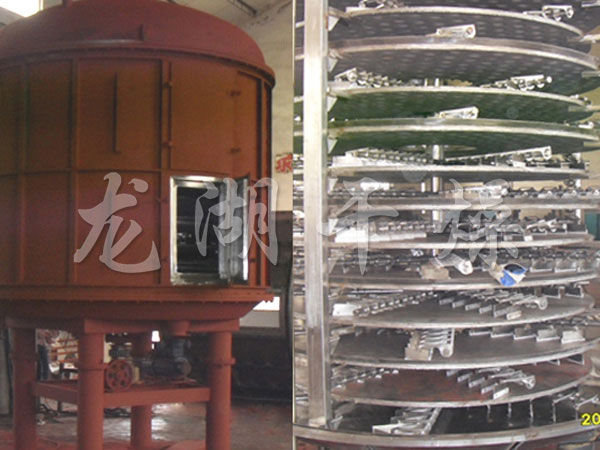Product
 Calcium hydrogen phosphate disk dryer
Materials: Calcium hydrogen phosphate
Product:
Description:Calcium hydrogen phosphate, a chemical, is the reaction product of phosphoric acid and calcium. This product is white powder; Odorless, tasteless, soluble in dilute hydrochloric acid or dilute nitric acid. Food industry as a loosening agent. Dough improver, buffer, nutrition supplement, emulsifier, stabilizer, etc. For example, it is used as a leavening agent for flour, cake, pastry and baked goods, a compound bread modifier, and a fried food modifier. It is also used for biscuits, milk powder, cold drinks, ice cream powder, and as a nutritional supplement or quality improver.
Details
Calcium hydrogen phosphate disk dryer
Materials: Calcium hydrogen phosphate
Product:
Description:Calcium hydrogen phosphate, a chemical, is the reaction product of phosphoric acid and calcium. This product is white powder; Odorless, tasteless, soluble in dilute hydrochloric acid or dilute nitric acid. Food industry as a loosening agent. Dough improver, buffer, nutrition supplement, emulsifier, stabilizer, etc. For example, it is used as a leavening agent for flour, cake, pastry and baked goods, a compound bread modifier, and a fried food modifier. It is also used for biscuits, milk powder, cold drinks, ice cream powder, and as a nutritional supplement or quality improver.
Details
Calcium hydrogen phosphate, a chemical, is the reaction product of phosphoric acid and calcium. This product is white powder; Odorless, tasteless, soluble in dilute hydrochloric acid or dilute nitric acid. Food industry as a loosening agent. Dough improver, buffer, nutrition supplement, emulsifier, stabilizer, etc. For example, it is used as a leavening agent for flour, cake, pastry and baked goods, a compound bread modifier, and a fried food modifier. It is also used for biscuits, milk powder, cold drinks, ice cream powder, and as a nutritional supplement or quality improver.
Principle of calcium hydrogen phosphate disk dryer:
The wet material is continuously added to the first layer of drying plate on the upper part of the dryer from the feeder, and the rake arm with the rake blade rotates to make the rake blade continuously turn over the material. The material flows through the surface of the drying plate along the exponential spiral. The material on the small drying plate is transferred to the outer edge, and falls to the outer edge of the large drying plate below. The material on the large drying plate moves inward and falls into the next small drying plate from the middle dropping hole. The large and small drying plates are arranged alternately up and down, so that the materials can continuously flow through the whole dryer. The heating medium (in the form of saturated steam, hot water and heat transfer oil) is introduced into the hollow drying plate. The heating medium enters from one end of the drying plate and exits from the other end. The dried material falls to the bottom layer of the shell from the next layer of drying plate, and then is transported to the discharge port by the rake blade. The moisture is discharged from the moisture drain on the top cover. The production capacity and effect of the dryer can be improved by adding auxiliary machines such as fin heater, solvent recovery condenser, bag filter, dry material back-mixing mechanism, induced draft fan, etc., and pyrolysis and reaction operation can also be carried out. The equipment combines the advantages of conduction drying and mixing transportation. The structure adopts the ingenious combination of large and small heating plates welded by sheet stamping and swing adjustable rotary rake blades, with quantitative feeding and stepless speed regulation; In the process, measures such as series-parallel input of heating medium and end cooling are adopted. The material layer is thin, the thermal resistance is small, the exposed surface is large, and the heating area is 100% utilized, giving full play to the advantages of high heat utilization rate of conduction drying. The practice shows that the equipment has novel and compact structure, closed and continuous production, simple mediation and maintenance, stable and reliable operation, large elasticity, high efficiency, low energy consumption and controllable drying time.
Application of calcium hydrogen phosphate disc dryer:
The drying equipment is mainly used for drying and cooling powder and granular materials in medical intermediates, pesticides, chemicals, pharmaceuticals, food, feed and other industries.
1. Organic chemical industry: polyvinyl chloride resin, polytetrafluoroethylene resin, fumaric acid, anthraquinone, nitroanthraquinone, p-aminophenol, melamine, cyanuric acid, p-aminobenzoic acid, antioxidant 168, naphthol AS, stearate, aniline, nitroaniline, dipentaerythritol, chlorinated paraffin, calcium formate, triethylenediamine, sodium benzenesulfonate, isophthalic acid, sodium dimethyl pentasulfonate, thiourea, oil-soluble aniline black dye Organic chemical raw materials and intermediates such as acid black dyes.
II. Inorganic chemical industry: light calcium carbonate, active calcium carbonate, nano-sized ultra-fine calcium carbonate, magnesium carbonate, aluminum hydroxide, white carbon black, strontium carbonate, barium carbonate, methyl carbonate, lithopone, sodium hydroxide, potassium sulfate, microsphere catalyst, magnesium hydroxide, copper sulfate, nickel sulfate, ammonium nickel sulfate, sodium molybdate, sodium chloride, potassium chloride, calcium chloride, sodium fluoride, cryolite, iron oxide red, lithium hydroxide, nickel hydroxide, zirconium hydroxide Calcium carbonate, sulfur, etc.
Three medicines and foods: ampicillin, Deng salt, levo-phenylglycine and intermediates, cefotaxime, ceftriazine, analgin, cimetidine, vitamin b, vitamin c, medicinal magnesium metasilicate, caffeine, tea, flower extract, ginkgo leaf, chocolate powder, starch, corn germ and other raw materials and pharmaceutical intermediates.
IV. Feed and fertilizer: potassium carbonate, biological potassium fertilizer, protein feed, chlortetracycline for feed, bran, distiller's grains, grain, herbicide, cellulose, feed calcium hydrogen phosphate, etc.
Previous Information: Sodium chloride waste water evaporator
Next Information:None!
product